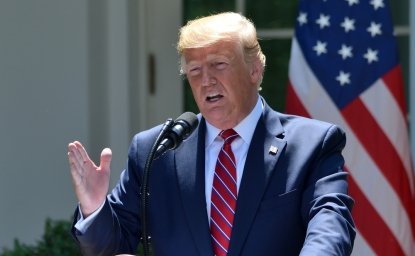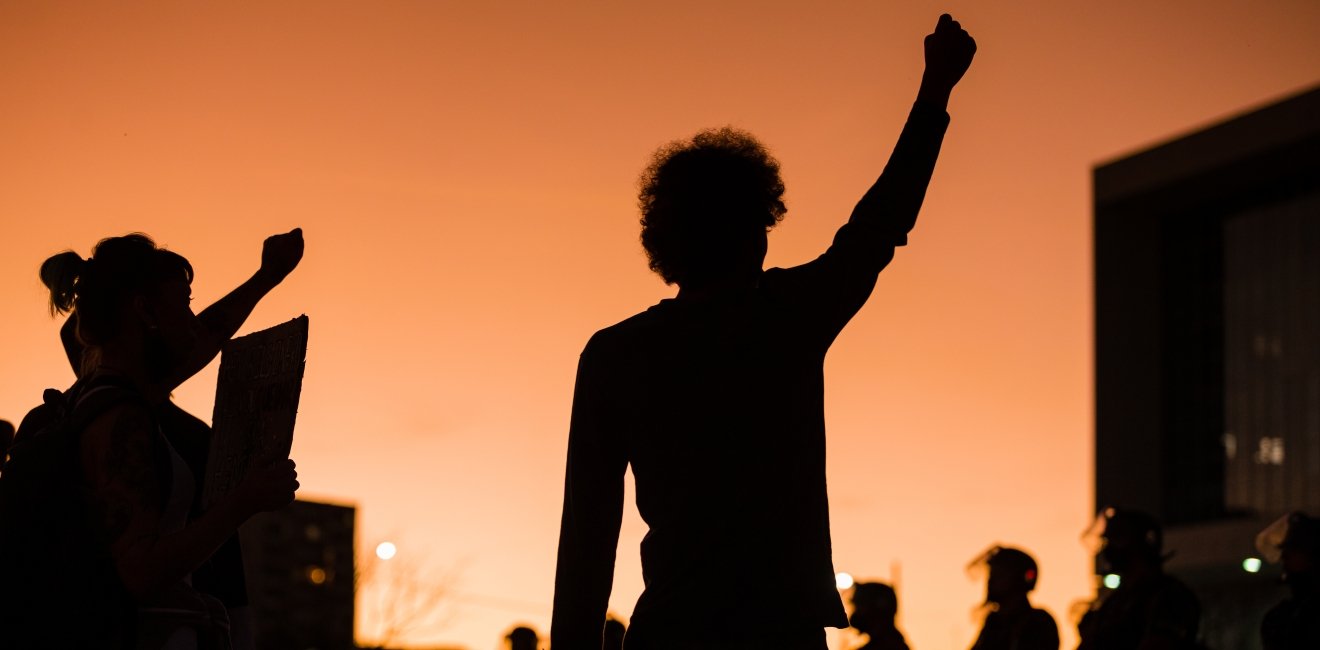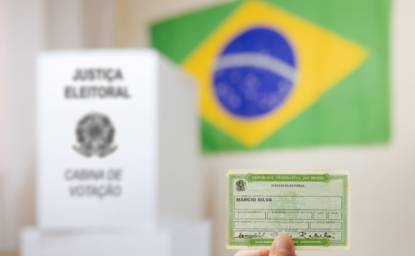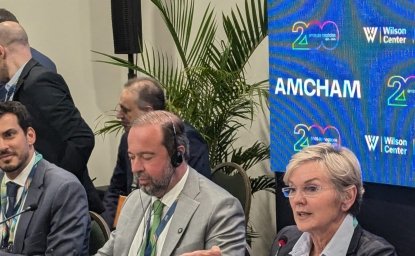
A blog of the Brazil Institute
“João Pedro?” Rafaela Matos asked her son.
“Yes,” he replied.
“Is your uncle with you? Or is it just you and Nathan? There is a shooting there, right? I’m worried.”
“My uncle is coming.”
“Your father is at the store. Is the shooting really there, where you are?”
“I’m inside the house. Don’t worry.”
This conversation between Rafaela Matos and her son, João Pedro Matos, occurred on WhatsApp on May 18, 2020 just minutes before a police helicopter flew over their neighborhood in São Gonçalo, in the state of Rio de Janeiro. João Pedro was with four friends and his cousin Nathan on the terrace while his parents were working. They ran inside when the shooting began. The house was shot sixty-four times, with bullets hitting fourteen-year old João Pedro in the back. He died.
Photos of João Pedro went viral across the internet, and the case gained national recognition. But he was soon forgotten, reduced to a statistic. In the first six months of 2020, over forty children and teenagers[1] were shot in the Rio de Janeiro metropolitan area[2]; seventeen of those forty were fatally wounded, with five by stray bullets. The number of fatalities in 2020 represents a 100 percent increase from the number of children and teenagers who died in the same period in 2019.
National-level data show that this pattern is not restricted to Rio de Janeiro. Between 2001 and 2018, over 140,000 children and teenagers (0-19 years old) were killed in firearm-related incidents, 70 percent of whom were Black. According to World Health Organization (WHO) data, Brazil has the third highest homicide rate for children and teenagers (16.3 people per 100,000), behind only Mexico (26.7) and El Salvador (17.5). Yet no legal action has been taken by either Brazil's legislative or executive branch to protect future generations. We argue that external pressures—such as the mobilization of civil society—is likely needed to push the government to safeguard Brazil’s youth.
Who are the Children?
Approximately 7,807 children and teenagers die each year from gun-related violence in Brazil, and a disproportionate percentage are Black.[3] As of 2018, 55.5 percent of the Brazilian population is Black[4] and 43.1 percent is White; but as Figure 1 shows, of the 10,821 children killed by firearms between 2001 and 2018, 7,352 were Black (68 percent). The number of deaths among White children totaled 2,713 (25 percent).
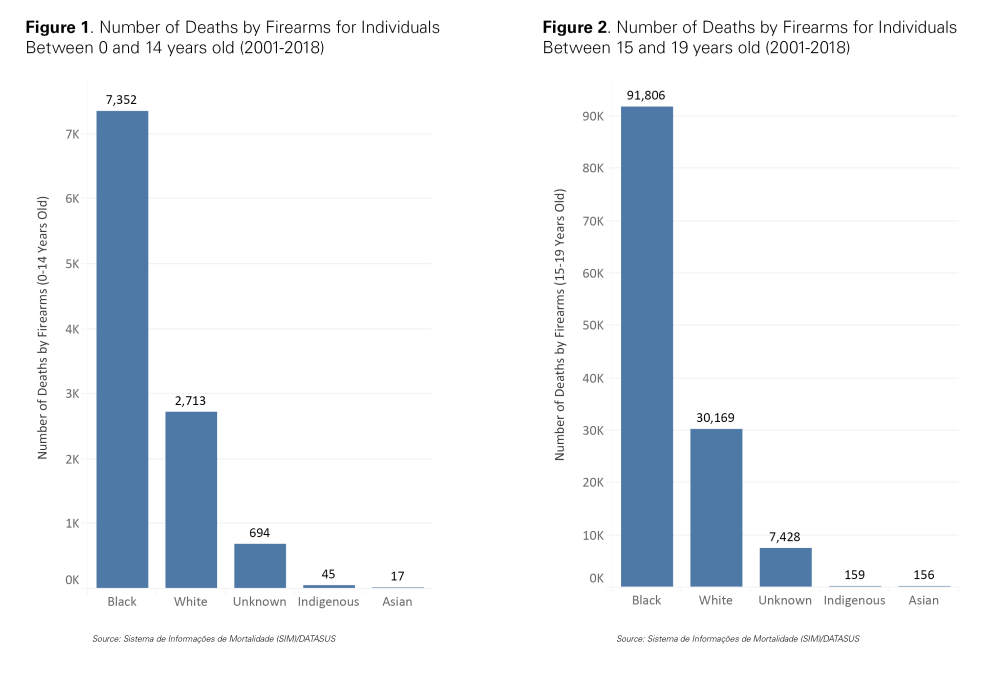
The data on individuals between 15 and 19 years old show a similar breakdown. As portrayed in Figure 2, of the 129,718 teenage deaths from firearms within the same period, 91,806 were Black (70 percent). The total number of deaths among White teenagers was 30,169 (23 percent).
There is no readily available time-series, national-level data that link deaths by firearms to police action. As such, it is not possible to ascertain how many firearm-related deaths are the result of state violence. Existing data remain incomplete at best. However, the Brazilian Public Security Forum estimates that in 2017 and 2018, 2,884 children and teenagers were killed in police interventions in the country.[1] Furthermore, UNICEF data show that Civil and Military Police actions were the main cause of non-accidental deaths of children and teenagers between 2014 and 2018 in the state of São Paulo. Within that period, police killed 580 children and teenagers in São Paulo. Unfortunately, data from both sources are not categorized according to race.
What has the Government Done?
Firearm deaths among children and teenagers has attracted scant attention across the branches of government. The issue first appeared on the congressional agenda in 1992, when legislators created a Parliamentary Inquiry Committee (CPI) in the Chamber of Deputies to investigate the high number of killings of children and teenagers. Of the eight bills proposed by the CPI, only two passed and became law. The first restricts the activity of private security companies and the second removes special privileges from military police officers who commit crimes against civilians (in particular, the law stipulates that police officers would no longer possess qualified immunity). Several of the bills that did not pass were highly contentious, as in the case of bill 2806/1992, which would have created a National Code for Gun Ownership. The CPI intended to change gun sales laws by restricting the pool of eligible purchases to those authorized by the government to use firearms in a professional capacity. “The time has come to disarm society,” deputies wrote in the bill justification. In 2005, the disarmament issue reappeared on the congressional agenda. In a referendum that asked if the government should prohibit the selling of firearms and ammunition, 64 percent of Brazilians voted no.
As the problem persisted, legislators instituted another CPI in 2015, housed in the Senate, to examine homicides among the young population. During the inquiry process, senators determined that firearm homicides disproportionately affected Black Brazilians and, as a result, they decided to shift the CPI’s focus to the killing of Black youth by the Brazilian state. Senators invited researchers, social activists, and parents who had lost their daughters and sons to participate in the CPI’s debates. Their work resulted in a single draft bill (PLS 240/2016) that proposed a National Plan to Combat the Killing of Young People.
The Plan is designed to reduce the number of youth homicides to less than ten for every 100,000 people over the next ten years. It would also seek to prosecute up to 80 percent of crimes against children and teenagers, which holds implications for deaths caused by police intervention. For example, of the 3,441 killings committed by the police in Rio de Janeiro between 2010 and 2015, only four cases were prosecuted (0.1 percent). The Senate approved the bill, which then went to the Chamber of Deputies in 2018, where it received another identification number (PL 9796/2018[2]). A Special Committee in the Chamber approved the bill in 2018, leaving it ready for a floor vote. However, deputies have neglected the bill, and it remains in legislative limbo.[3]
On the executive side, our survey of executive branch policies identifies only one program focused on the issue: the Program for the Reduction of Lethal Violence Against Adolescents and Youth (PRVL), enacted by the Lula administration in partnership with UNICEF and the Favelas Observatory in 2009. The program had three goals: mobilize key societal actors, produce indicators to measure lethality, and systematically analyze successful cases of mortality reduction among young populations. However, the PRVL is no longer active; it appears to have been discontinued during the Dilma Rousseff administration.
Why the Lack of Action?
The lack of action to address the violence against children and teenagers has a twofold explanation. First, although the problem is pressing, it has been sidelined by inconsistent and short-lived policy approaches that failed to reduce gun violence. According to Eduardo Soares, the two Cardoso administrations (1995-2002) took only incremental steps in addressing law and crime. As a result, problems compounded into the first Lula administration. For instance, homicide rates in the country increased from 21.84 people per 100,000 in 1995 to a rate of 28.53 per 100,000 people in 2002 (the current rate is even higher, at 31.59). Within the same period, the number of 15 to 29-year old young adults murdered jumped from 18,924 to 27,757.[4] Concurrently, the electoral costs of addressing law and crime issues also increased. Soares maintains that fears of failure and popular blame made President Lula reluctant to implement his own National Public Security Plan. President Lula eventually enacted the National Plan of Public Security and Citizenship (PRONASCI) in his second term; however, this plan was later discontinued by his successor Dilma Rousseff. This policy discontinuity across administrations has been a major roadblock for addressing law and crime issues.
Not all policy areas show such discontinuity. In the case of economic development, recent research by Marcus André Melo, Carlos Pereira, and colleagues has considered dominant belief[5] to be one of the main drivers of sustained growth in Brazil between 1994 and 2014. According to the authors, a shared belief among elites in “fiscally sound social inclusion” led policymakers to adopt policies and institutions that facilitated this growth. Healthcare policy provides another example. In the National Constituent Assembly of 1987-1988, debates over access to healthcare as a human right led to the nearly unanimous decision among legislators to establish a free and universal health care system: the Sistema Único de Saúde (SUS). Both the right and left agreed it should be one of the foundations of Brazilian society, and this agreement was codified in the 1988 Constitution. Subsequently, no elected government has tried to discontinue the SUS. Politicians can criticize how their opponents manage the SUS, but they do not attempt to overhaul it.
We infer that the lack of a dominant belief regarding law and crime[6] has led to both policy discontinuity in this area and the lack of attention to the issue of violence against children and teenagers. While members of the Constituent Assembly discussed matters of law and crime, debates did not advance a democratic consensus between the left and the right. Rather—as suggested by Natália de Oliveira Fountoura and her colleagues—the lack of a coherent proposal from the left combined with lobbying from the Armed Forces, police associations, and police chiefs sustained the institutional model from the dictatorship.[7] As Luiz Eduardo Soares puts it, “our democratic transition did not extend to law and crime.”
Second, the lack of policy action related to violence against children and teenagers is also a product of cognitive and institutional constraints. Cognitively, policymakers can only focus on a limited set of issues at one time. Institutionally, democratic rules and procedures (such as the need to build majorities in legislatures to pass a bill) create friction that delay policy responses. As a result, governments tend to ignore issues for long periods of time. This dynamic helps explain why the bill that creates a National Plan to Combat the Killing of Young People remains in legislative limbo. While there was an attempt by a few legislators to schedule a vote earlier this year, deputies’ attention shifted to a more pressing issue—the pandemic. Furthermore, the bill has encountered resistance from organized congressional groups, such as the public security bloc,[8] which prevents a frictionless approval.
Yet as societal problems grow worse, they become more pressing and eventually need to be addressed. Policy almost never changes until it does—in dramatic ways. Sudden changes usually occur when policymakers have no other option but to pay attention to policy problems. This shift can happen when a policy entrepreneur convinces politicians to gather support to approve a bill. Certain events can also serve as fire alarms for decision-makers; and one of them is popular support.
Given the absence of broad consensus on law and crime, the mobilization of civil society against the killing of children and teenagers might be the only feasible way to tackle the issue in the near future. This type of strategy has shown success in other areas. In the last two decades, societal groups have offered policy information and popular support for Brazilian lawmakers to move education bills through the legislative process into law. The National Campaign for the Right to Education and All for Education movements actively participated in advancing the National Plan of Education, signed into law in 2014. More recently, these organizations pressured federal deputies and the Executive branch to approve the National Fund for Basic Education (Fundeb) in the Chamber of Deputies. Civil society could mimic the campaigns surrounding education to gain the attention of policymakers on the issues of gun violence and its impact on Brazilian youth.
A window of opportunity currently exists to address this issue. In the congressional arena, bill 9796/2018 has gone through most stages of the legislative process and has been widely discussed with civil society. Unlike the 1992 CPI, which proposed piecemeal legislative efforts, the 2015 CPI offers broad national guidelines and goals. For example, the bill details how the federal government, states, and municipalities should pursue the ends described above, such as the reduction of the number of youth homicides to less than ten for every 100,000 people over the next ten years. In this sense, bill 9796/2018 provides a consensus-based roadmap for future political negotiation. As such, it is less likely to encounter resistance from groups within Congress. Additionally, while a lack of data on race makes it hard to target policy solutions for Black children and teenagers, addressing the broader issue of police violence will also affect this vulnerable population. More broadly, there is now renewed focus on the intersection of race and police violence in Brazil. Popular mobilization in turn could capture the attention of one or more legislators who could become policy entrepreneurs within the Chamber of Deputies. Brazilian policymakers failed to protect the lives of João Pedro and thousands of others, but pulling this policy conversation out of limbo would represent a first step towards preventing future deaths of children and teenagers.
Notes
[1] We use the words children and teenagers interchangeably. The United Nations defines a child as any person below the age of 18.
[2] Data were collected by Fogo Cruzado, an organization that monitors violence in Rio de Janeiro. Their database considers “children” individuals whose age is below 12 years old, and “teenagers” individuals whose age is above 12 years old.
[3] Data from the Sistema de Informações de Mortalidade (SIM)/DATASUS of the Brazilian Ministry of Health. The numbers refer to the period of 2001 and 2018 for individuals between 0 and 19 years old who were killed by firearms. The deaths are related to the following CID10 arguments (all of which touch upon the issue of deaths by firearms): W33, W34, X72, X74, X93, X94, X95, Y23, and Y24. Individuals between 0 and 14 are considered children. Individuals between 15 and 19 are considered teenagers. Black individuals are those under the categories “pardos” and “pretos.”
[4] The Instituto Brasileiro de Geografia e Estatística (IBGE) includes both “pardos” and “pretos” as “Black.”
[5] The DATASUS and Brazilian Public Security Forum databases collect data on different aspects of gun violence and are thus not directly comparable. DATASUS estimates that 18,071 children and teenagers (0-19 years old) were killed by firearms in 2018 and 2017. As mentioned above, the Brazilian Public Security Forum estimates that 2,884 children and teenagers were killed in police interventions within the same period and age range.
[6] Five other existing bills about the same issue have been attached (apensados) to the PL 9796/2018: PL 2438/2015, PL 7148/2017, PL 1843/2019, PL 9322/2017, and PL 3873/2019.
[7] Data comparing the approval rates of bills discussed in Standing and Special Committees are not readily available. The work of Fernando Saboia Vieira suggests that bills discussed in Special Committees may commonly languish in limbo. Focusing on the Chamber of Deputies, the author highlights that Special Committees are often created by the president of the Chamber and party leaders to avoid bill approval.
[8] Data from the Brazilian Public Security Forum and the Institute for Applied Economic Research (IPEA). The calculation of the number of homicides for 15-29 year-olds takes into account two sets of CIDs 10 arguments from the Brazilian Ministry of Health: X85-Y09 and Y35-36.
[9] The authors define beliefs as the “mental constructs mapping institutions onto outcomes.”
[10] In other words, there is no policy paradigm for law and crime in Brazil. According to Peter Hall, a policy paradigm refers to “not only the goals of the policy and the kind of instruments that can be used to attain them, but also to the very nature of the problems they are meant to be addressing.”
[11] This arrangement includes the existence of two police forces: the Civil police and the Military police (which is subordinated to the Armed Forces).
[12] We use this term to refer to the congressional organizations known in the United States as legislative member organizations (LMOs). Examples of LMOs in the American context are the Hispanic and the Freedom caucus.
Authors


Brazil Institute
The Brazil Institute—the only country-specific policy institution focused on Brazil in Washington—aims to deepen understanding of Brazil’s complex landscape and strengthen relations between Brazilian and US institutions across all sectors. Read more

Explore More in Brazil Builds
Browse Brazil Builds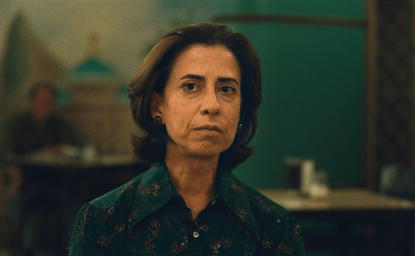
They're Still Here: Brazil's unfinished reckoning with military impunity
